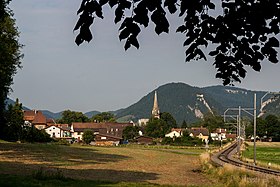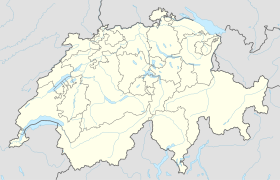Môtiers
| Môtiers | ||
|---|---|---|
| State : |
|
|
| Canton : |
|
|
| District : | No district division | |
| Municipality : | Val-de-Travers | |
| Postal code : | 2112 | |
| former BFS no. : | 6507 | |
| Coordinates : | 537 067 / 196 044 | |
| Height : | 737 m above sea level M. | |
| Area : | 6.42 km² | |
| Residents: | 825 (December 31, 2007) | |
| Population density : | 129 inhabitants per km² | |
|
Môtiers |
||
| map | ||
|
|
||
Môtiers (NE) was a municipality in the Val-de-Travers district of the Swiss canton of Neuchâtel until December 31, 2008 .
It is not to be confused with the homophonic Fribourgese village of Môtier (municipality Mont-Vully ) at Mont Vully and was therefore from the Federal Statistical Office in the official spelling of Canton shortcuts provided .
Since January 1, 2009 Môtiers belongs together with Boveresse , Buttes , Couvet , Fleurier , Les Bayards , Noiraigue , Saint-Sulpice and Travers merged to Val-de-Travers .
geography
Môtiers is 737 m above sea level. M. , 26 kilometers west-southwest of the canton capital Neuchâtel (linear distance ). The clustered village extends in the western Val de Travers in the flat valley floor south of the Areuse and on the Dorfbach Bied in the Neuchâtel Jura .
The area of the 6.4 km² former municipal area comprises a section in the Val de Travers. The northern border was partly the corrected and straightened Areuse, partly also the former river course, now called Vieille Areuse . To the south, the municipality extended over the flat valley floor to the adjacent anticline of the Chasseron , which is divided here by the erosion valleys of the Bied and its tributaries. In the southeast the area extended to the plateau Nouvelle Censière , on which there are extensive Jura high pastures with the typical mighty spruce trees , which either stand individually or in groups. The highest point of Môtiers was 1270 m above sea level. M. at the height of the Chasseron chain. In 1997, 8% of the municipal area was in settlements, 50% in forests and woodlands, 40% in agriculture and a little more than 1% was unproductive land.
Môtiers owned a few individual farms in the valley and on the heights of the Chasseron chain. Neighboring communities of Môtiers were Fleurier , Boveresse and Couvet in the canton of Neuchâtel and Provence and Romairon in the canton of Vaud .
population
With 825 inhabitants (at the end of 2007), Môtiers was one of the smaller communities in the canton of Neuchâtel. 93.8% of the residents are French-speaking, 2.6% German-speaking and 1.1% Italian-speaking (as of 2000). The population of Môtiers rose continuously until 1900 (1043 inhabitants), after which it decreased and leveled off at around 800 inhabitants.
economy
Until the middle of the 19th century, Môtiers was mainly an agricultural community. Then the structure of employment changed with the establishment of watchmaking and textile factories and a tannery. An important line of business for the residents of Môtiers was the cultivation of the absinthe plant ( Artemisia absinthium ) for the production of absinthe , which was banned in 1908 due to a referendum. Today the inhabitants live from agriculture, with cattle breeding and dairy farming predominating, and from the production of wine and sparkling wine (Champagne suisse). An IT company and local small businesses offer additional jobs . However, many workers are commuters and work in the larger towns of the Val de Travers or in Neuchâtel.
traffic
The former community is well developed in terms of traffic. It is located on the former main road from Couvet to Fleurier. Today's national main road from Neuchâtel via the border crossing Les Verrières to Pontarlier in France runs on the northern side of the valley. On September 24, 1883, the railway line from Travers to Saint-Sulpice was opened with a station in Môtiers.
history
Môtiers is the oldest municipality in the Val de Travers. Its name is derived from the Latin monasterium . Other names in the course of time were Mostiers , Moustiers and Moutier . In the 10th century Benedictine monks founded a monastery in what is now the municipality of Môtiers and began to reclaim the Val de Travers, which at that time belonged to the territory of the Kingdom of Burgundy . There was probably a church here as early as the 8th century. The Benedictine priory of Saint-Pierre in Môtiers was initially a branch of the Cluny Monastery , from 1107 it belonged to the French Abbey of La Chaise-Dieu until its dissolution after the Reformation .
The village of Môtiers gradually developed around the monastery. The priory held both ecclesiastical and secular rule over the Val de Travers until the valley came to the Counts of Neuchâtel in 1237 as a fief from the Free County of Burgundy. These increased their influence on the valley, especially from the 14th century, which they underpinned with the construction of the castle in 1344 above Môtiers. The castle became the seat of the Kastlanei Vautravers (also called Val-de-Travers) and Môtiers the regional center of the valley with a market hall, the Hôtel des Six Communes, in which a weekly market was held every quarter. As a result, the power of the priory fell sharply and ended with secularization in 1536; the monks emigrated to France.
The sovereignty of the area remained with Neuchâtel, which became a principality in 1648 and was linked to the Kingdom of Prussia from 1707 through a personal union. In 1806 the area was ceded to Napoleon I and came to the Swiss Confederation in the course of the Congress of Vienna in 1815 , whereby the kings of Prussia until 1848 (formally until the Neuchâtel trade in 1857) also remained princes of Neuchâtel.
Numerous houses in Môtiers fell victim to a village fire in 1723. From 1762 to 1765 the place was the residence of Jean-Jacques Rousseau . During the industrialization of the Val de Travers, Môtiers remained in development compared to the neighboring villages of Fleurier and Couvet, but retained its status as the seat of the Kastlanei and became the capital of the Val-de-Travers district after 1848.
Attractions
Môtiers has retained its picturesque townscape. The convent buildings have undergone numerous changes over the centuries. The oldest components are Romanesque and date from the 11th and 12th centuries. After secularization, the buildings were the residence of the tax bailiff and since 1829 they have housed a sparkling wine factory. Most of today's buildings date from the 16th to 18th centuries. The Reformed Church of Môtiers is a Gothic building that was built between 1460 and 1490; the polygonal choir and the front tower date from 1669 to 1679.
The Hôtel des Six Communes, the former market hall, stands on the village square. The current building with arched arcades and Gothic windows on the upper floor was built in 1612. Other important buildings in the historic center of the village are the Maison Boy de la Tour, a 1720-23 built mansion in Regency style, the Maison Bobillier (1767), the Maison Rousseau with a museum dedicated to Jean-Jacques Rousseau, and the Maison des Mascarons. The latter houses the regional museum with historical and folkloric exhibits as well as a section on the history of absinthe production in Val de Travers.
The castle of Môtiers (Vieux-Château) stands on a rock spur between the Val de Travers and the Tal dies Bied, the oldest parts of which, including the Tour de Diesse, date from the 14th century. In the later centuries the castle was rebuilt several times and the last time it was restored in 1957–72. Today it belongs to the state of Neuchâtel and is occasionally used for cultural events.
Right behind the castle is one of the most beautiful gorges in the Jura . The Bied is a tributary river of the Areuse and has dug its way through the Jurassic rock over millions of years. The path was first expanded in 1946 and connects the village of Môtiers with some individual farms. The trail is now maintained by the canton and needs repairs every year. The gorge is extremely steep, especially in the upper part, and can therefore only be accessed via secured wooden walkways and stairs carved into the rock.
photos
literature
- Eric-André Klauser: Môtiers (NE). In: Historical Lexicon of Switzerland .
- Jean Courvoisier: The Art Monuments of the Canton of Neuchâtel, Volume III: Les districts du Valde-Travers, du Val-de-Ruz, du Locle et de La Chaux-de-Fonds. (= Art Monuments of Switzerland. Volume 56). Edited by the Society for Swiss Art History GSK. Bern 1968.
Web links
- Official website of the former municipality of Môtiers. 2004 to 2008. Archived from the original on March 7, 2008 ; Retrieved on August 31, 2011 (French).









